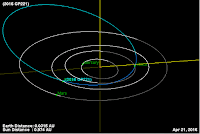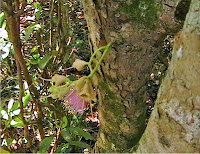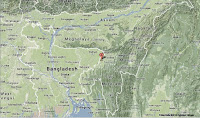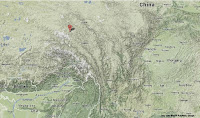The American Meteor Society has received reports of a bright fireball meteor being seen over much of
southern California slightly at about 9.30 pm local time on Monday 23 April 2016 (about 4.30 am on Tuesday 24 April GMT).
The fireball has been described as being greenish in colour, which may
indicate it was caused by the explosion of a small meteorite with a high
iron content, and was seen from the northern Baja California as far north as Mendocino County, and east to western Arizona, though the majority of sightings were in Southern California. A fireball is defined as a meteor
(shooting star) brighter than the
planet Venus. These are typically caused by pieces of rock burning up in
the atmosphere, but can be the result of man-made space-junk burning up
on re-entry.
Fireball over Southern California on Monday 23 April 2016. CBS2.
Objects of this size probably enter the Earth's atmosphere several times
a year, though unless they do so over populated areas they are unlikely
to be noticed. They are officially described as fireballs if they
produce a light brighter than the planet Venus. It is possible that this object will have produced meteorites that reached
the surface (an object visible in the sky is a meteor, a rock that falls
from the sky and can be physically held and examined is a meteorite).
Witness reports can help astronomers to understand these events. If you
witnessed this fireball you can report it to the American Meteor Society here.
See also...
 Bright 'fireball' meteor seen over much of England. The UK Meteor Observation Network
has received reports of a bright fireball meteor being seen over much
of southern England slightly after 3.15 am GMT...
Bright 'fireball' meteor seen over much of England. The UK Meteor Observation Network
has received reports of a bright fireball meteor being seen over much
of southern England slightly after 3.15 am GMT...  Fireball seen over southern France and northern Italy. A bright fireball was seen over much of southeast France and northern
Italy at about 6.20 pm local time on Wednesday 17...
Fireball seen over southern France and northern Italy. A bright fireball was seen over much of southeast France and northern
Italy at about 6.20 pm local time on Wednesday 17... Meteorite unlikely to have killed man in Tamil Nadu. Indian newspaper The Hindu carried a report
on Sunday 7 February 2016 in which the death of a man and injury of
three other people as well as causing damage to several nearby buildings
at the campus of a college in Vellore, Tamil Nadu, were described as...
Meteorite unlikely to have killed man in Tamil Nadu. Indian newspaper The Hindu carried a report
on Sunday 7 February 2016 in which the death of a man and injury of
three other people as well as causing damage to several nearby buildings
at the campus of a college in Vellore, Tamil Nadu, were described as...
Follow Sciency Thoughts on Facebook.



































